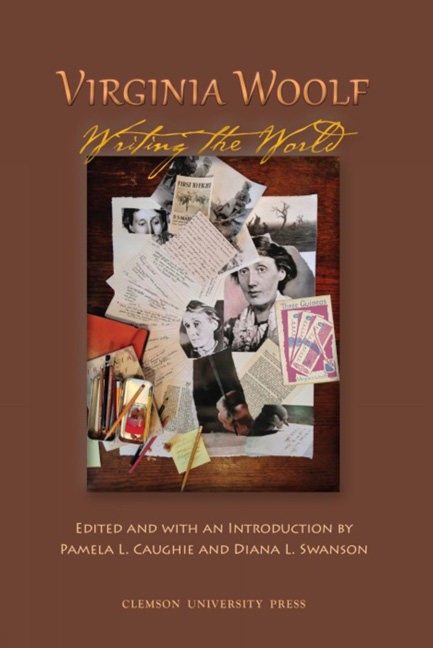Book contents
- Frontmatter
- Table of Contents
- Introduction
- Acknowledgmen
- Abbreviation
- WAR AND PEACE
- Roundtable: Woolf and Violence
- Intersections: Surveillance, Propaganda, and Just War
- Modernism and Memorials: Virginia Woolf and Christopher Isherwood
- Taking Up Her Pen for World Peace: Virginia Woolf, Feminist Pacifist. Or Not?
- The Sex War and the Great War: Woolf's Late Victorian Inheritance in Three Guineas
- Sky Haunting: The British Motor-Car Industry and the World Wars
- The 1914 “Expurgated Chunk”: The Great War in and out of The Years
- “beauty, simplicity and peace”: Faithful Pacifism, Activist Writing, and The Years
- Virginia Woolf, Katharine Burdekin, and Britain's Cosmopolitan Musical Culture
- Death in the Air: Virginia Woolf and Sylvia Townsend Warner in World War II
- WORLD WRITER(S)
- ANIMAL AND NATURAL WORLD
- WRITING AND WORLDMAKING
- Notes on Contributors
- Conference Program
- Appendix: Virginia Woolf Conference Exhibit Items, Newberry Library
Taking Up Her Pen for World Peace: Virginia Woolf, Feminist Pacifist. Or Not?
from WAR AND PEACE
- Frontmatter
- Table of Contents
- Introduction
- Acknowledgmen
- Abbreviation
- WAR AND PEACE
- Roundtable: Woolf and Violence
- Intersections: Surveillance, Propaganda, and Just War
- Modernism and Memorials: Virginia Woolf and Christopher Isherwood
- Taking Up Her Pen for World Peace: Virginia Woolf, Feminist Pacifist. Or Not?
- The Sex War and the Great War: Woolf's Late Victorian Inheritance in Three Guineas
- Sky Haunting: The British Motor-Car Industry and the World Wars
- The 1914 “Expurgated Chunk”: The Great War in and out of The Years
- “beauty, simplicity and peace”: Faithful Pacifism, Activist Writing, and The Years
- Virginia Woolf, Katharine Burdekin, and Britain's Cosmopolitan Musical Culture
- Death in the Air: Virginia Woolf and Sylvia Townsend Warner in World War II
- WORLD WRITER(S)
- ANIMAL AND NATURAL WORLD
- WRITING AND WORLDMAKING
- Notes on Contributors
- Conference Program
- Appendix: Virginia Woolf Conference Exhibit Items, Newberry Library
Summary
Words. Virginia Woolf used them. And she described them. She called them wild. She called them free. She spoke of them as irresponsible but sensitive, democratic but un-teachable, self-conscious but unwilling to be confined. Words, she said in her 1937 BBC radio broadcast, are changeable. They take on one meaning, then another. They convey truths that are many-sided. They mean one thing to you, another thing to me. Words, she knew, have power. They have the power to express our thoughts and our emotions and the power to provide meaning that transcends generations. Words also have the power to liberate our thinking from the routine and from the stale—whether we are writing of the world at home or the world abroad.
In this paper, I will discuss two words that have been applied to Woolf, two words used to stamp her with an indelible label. These two words are used to deny her charmingly contradictory nature and to disallow her the changeability she grants to words themselves. The first word is feminist. The second word is pacifist. Like others before me, I will make the case that Woolf was both. Like others before me, I will also make the case that Woolf rejected both. Woolf, like words, was unwilling to be confined to one meaning. Woolf, like words, was changeable. Woolf, like words, can't be caught and sorted into a certain kind of order.
To make the case for Woolf as feminist and pacifist, as well as her refusal to label herself as either, I will provide a brief overview of her work as it relates to her feminist war resistance at home and abroad. I will then look at specific diary entries and letters dating from 1916 through 1938 in which Woolf refers to her own feminism and pacifism. I will also review passages in A Room of One's Own (1929) and Three Guineas (1938) that mention those concepts in general terms. In conclusion, I will discuss her 1940 essay, “Thoughts on Peace in an Air Raid,” which I argue she wrote from a feminist pacifist perspective that persisted throughout her life, despite her changeability.
- Type
- Chapter
- Information
- Virginia Woolf: Writing the World , pp. 37 - 42Publisher: Liverpool University PressPrint publication year: 2015



